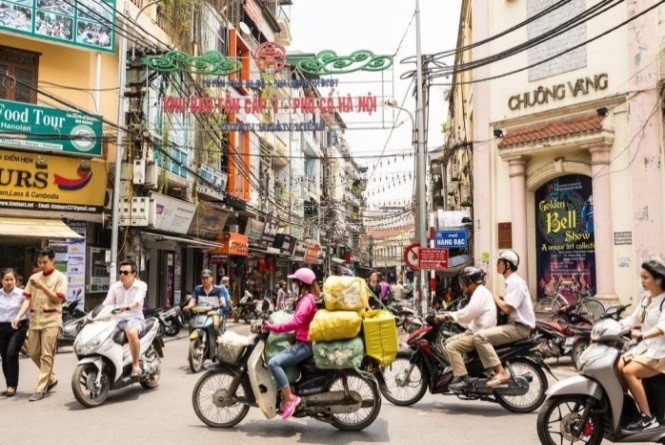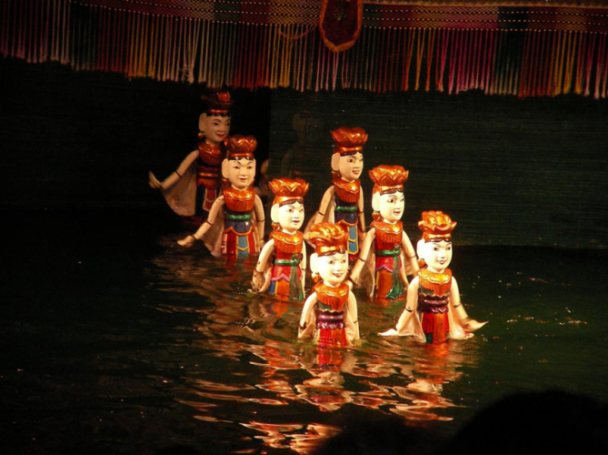Colleage's Tourism Website https://www.whyvietnam.info/
Hạ Long Bay

Hạ Long Bay (Vietnamese: Vịnh Hạ Long) is a UNESCO World Heritage Site and popular travel destination in Quảng Ninh Province, Vietnam. The name Hạ Long means "descending dragon". Administratively, the bay belongs to Hạ Long city, Cẩm Phả city, and is a part of Vân Đồn District. The bay features thousands of limestone karsts and isles in various shapes and sizes. Ha Long Bay is a center of a larger zone which includes Bai Tu Long Bay to the northeast, and Cát Bà Island to the southwest. These larger zones share a similar geological, geographical, geomorphological, climate, and cultural characters.
Source: https://en.wikipedia.org/wiki/H%E1%BA%A1_Long_Bay
Source: https://d3hne3c382ip58.cloudfront.net/files/uploads/bookmundi/resized/countrybanner/ha-long-bay-cruise-tour-1578030417-1920X700.jpg
St. Joseph's Cathedral, Hanoi

St. Joseph's Cathedral (Vietnamese: Nhà thờ Lớn Hà Nội, Nhà thờ Chính tòa Thánh Giuse; French: Cathédrale Saint-Joseph) is a church on Nha Chung (Church) Street in the Hoàn Kiếm District of Hanoi, Vietnam. It is a late 19th-century Gothic Revival (Neo-Gothic style) church that serves as the cathedral of the Roman Catholic Archdiocese of Hanoi to nearly 4 million Catholics in the country. The cathedral was named after Joseph, the patron saint of Vietnam and Indochina. Construction began in 1886, with the architectural style described as resembling Notre Dame de Paris. The church was one of the first structures built by the French colonial government in Indochina when it opened in December 1886. It is the oldest church in Hanoi. The cathedral conducts mass several times during the day. For Sunday evening mass at 6:00 PM, large crowds spill out into the streets. The prayer hymns are broadcast and Catholics who are unable to enter the cathedral congregate in the street and listen to hymns.
Source: https://en.wikipedia.org/wiki/St._Joseph%27s_Cathedral,_Hanoi
Source: https://i.pinimg.com/originals/e3/2c/e7/e32ce7c0ca914843ad3ce0ce876360b7.jpg
Old Quarter, Hanoi (Hà Nội 36 phố phường)

The Old Quarter is the name commonly given to the historical civic urban core of Hanoi, located outside the Imperial Citadel of Thăng Long. This quarter used to be the residential, manufacturing and commercial center, where each street was specialized in one specific type of manufacturing or commerce. Another common name referring to approximately the same area is the 36 streets (Vietnamese: Hà Nội 36 phố phường), after the 36 streets or guilds that used to make up the urban area of the city.
Source: https://en.wikipedia.org/wiki/Old_Quarter,_Hanoi
Source: https://www.flashpack.com/wp-content/uploads/2018/10/Hanoi-VCA-1.jpg
Water Puppetry

Water puppetry (Vietnamese: Múa rối nước, lit. "Making puppets dance on water") is a tradition that dates back as far as the 11th century when it originated in the villages of the Red River Delta area of northern Vietnam. Today's Vietnamese water puppetry is a unique variation on the ancient Asian puppet tradition. The puppets are made out of wood and then lacquered. The shows are performed in a waist-deep pool. A large bamboo rod supports the puppet under the water and is used by the puppeteers, who are normally hidden behind a screen, to control them. Thus the puppets appear to be moving over the water. When the rice fields would flood, the villagers would entertain each other using this form of puppet play.
Source: https://en.wikipedia.org/wiki/Water_puppetry
Source: https://encrypted-tbn0.gstatic.com/images?q=tbn:ANd9GcTtpt-MIUrskaI1kTF2DZZpY7OqbzupxxQoGz9VTpw1pSwU1ewUvQ&s
Hoàn Kiếm Lake

Hoan Kiem Lake (Vietnamese: Hồ Hoàn Kiếm, Hán tự, meaning "Lake of the Returned Sword" or "Lake of the Restored Sword"), also known as Hồ Gươm (Sword Lake), is a fresh water lake, measuring some 12 ha in the historical center of Hanoi, the capital city of Vietnam. In the past, the lake was variously named "Luc Thuy Lake" (Vietnamese: Hồ Lục Thủy, meaning "Green Water Lake"- aptly named for the water's color) or "Thuy Quan Lake" (Vietnamese: Hồ Thủy Quân, meaning "Mariner's Lake"). The lake is one of the major scenic spots in the city and serves as a focal point for its public life.
Source: https://en.wikipedia.org/wiki/Ho%C3%A0n_Ki%E1%BA%BFm_Lake
Source: https://i.pinimg.com/originals/57/00/a4/5700a4a847c97019264c964e4cce58e3.jpg
Ho Chi Minh Mausoleum

The President Ho Chi Minh Mausoleum (Vietnamese: Lăng Chủ tịch Hồ Chí Minh) is a mausoleum which serves as the resting place of Vietnamese Revolutionary leader & President Ho Chi Minh in Hanoi, Vietnam. It is a large building located in the center of Ba Dinh Square, where Ho, Chairman of the Workers' Party of Vietnam from 1951 until his death in 1969, read the Declaration of Independence on 2 September 1945, establishing the Democratic Republic of Vietnam. It is also known as Ba Đình Mausoleum (Vietnamese: Lăng Ba Đình) and is open to the public.
Source: https://en.wikipedia.org/wiki/Ho_Chi_Minh_Mausoleum
Source: https://cdn2.veltra.com/ptr/20171226104331_1677596779_10309_0.jpg?imwidth=480&impolicy=custom